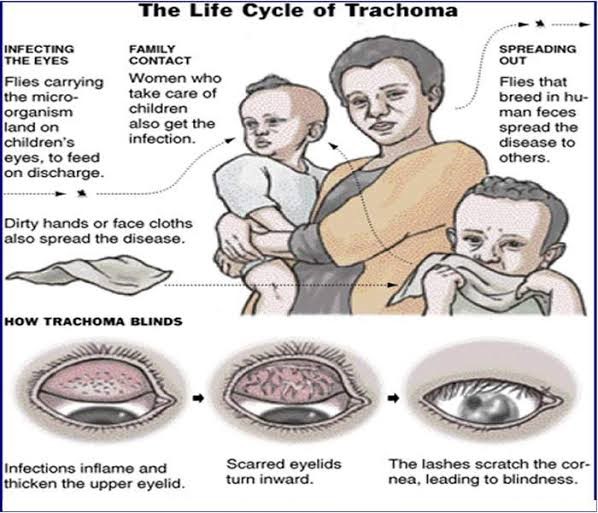India’s Triumph Over Trachoma
Syllabus:
GS 2:
- Welfare scheme for vulnerable sections of society related to Health.
- Government policies and intervention.
Why in the News?
India recently achieved the elimination of trachoma as a public health problem, a milestone with substantial health and economic impacts. Trachoma elimination highlights successful public health efforts and emphasizes the continued need for vigilance in preventing blindness across the country.
About Trachoma
- Bacterial Infection: Trachoma is an eye infection caused by Chlamydia trachomatis
- Contagious Spread: It spreads through contact with eye, nose, or throat secretions of infected individuals, potentially leading to blindness if untreated.
- High-Risk Communities: Commonly found in areas with poor sanitation and hygiene.
- WHO Classification: Recognized as a neglected tropical disease; affects 150 million people globally, with 6 million at risk of severe vision loss.
- Indian Government Initiatives: India launched the National Trachoma Control Program in 1963, later integrating it with the National Program for Control of Blindness (NPCB).
Significance of Trachoma Elimination
- Economic Impact: Trachoma-related blindness costs India approximately $2.9 to 5.3 billion annually in lost productivity, making its elimination economically significant.
- Health Milestone: India joins other developed countries in achieving trachoma elimination, reducing blindness and visual impairment rates.
- Impact on Vulnerable Groups: The disease primarily affects children and women in regions with limited access to sanitation, underscoring its disproportionate impact on marginalized groups.
- Success of SAFE Strategy: WHO’s SAFE strategy—surgery, antibiotics, facial cleanliness, and environmental improvement—proved pivotal in India’s trachoma elimination.
- Global Commitment: Trachoma elimination aligns with WHO’s goal of eradicating neglected tropical diseases (NTDs) by 2030, enhancing India’s commitment to global health targets.
Understanding Trachoma and Its Transmission
- Causing Agent: Trachoma, caused by Chlamydia trachomatis, leads to severe eye infections and, if untreated, can cause blindness due to eyelid scarring.
- Transmission Routes: It spreads through contact with contaminated surfaces or flies that have touched infected secretions, especially in poor sanitation areas.
- Impact on Children: The disease predominantly affects children in rural and underdeveloped regions, exacerbating health disparities.
- Living Conditions Factor: Overcrowded and unhygienic conditions increase transmission, particularly where access to clean water is limited.
- Public Health Challenge: Eradicating trachoma requires addressing underlying socio-economic conditions, a significant challenge in developing regions.
WHO’s Criteria for Trachoma Elimination
- Prevalence Thresholds: WHO’s elimination criteria include less than 0.2% prevalence of trichiasis in people over 15 and below 5% active trachoma cases in children.
- Health System Readiness: A responsive health system is essential for managing sporadic cases and preventing resurgence.
- Milestone Not Eradication: Elimination as a public health problem means reducing prevalence significantly but not achieving total disease eradication.
- Comparison with Other Diseases: Trachoma elimination differs from eradication seen in diseases like polio, where transmission has been reduced to near-zero.
- Continued Surveillance: Vigilant monitoring is crucial to maintaining low prevalence and addressing new cases promptly.
Epidemiological Challenges in Sustaining Elimination
- Ongoing Efforts Needed: Like a cricket team maintaining test status, maintaining elimination requires sustained efforts and resources.
- Absence of Vaccines: The lack of a trachoma vaccine means preventive efforts must focus on interrupting transmission cycles.
- Developed Countries’ Experience: Trachoma was eliminated in developed countries in the 1950s, showing that sustained improvements can yield long-term success.
- Risk of Resurgence: Without vigilance, trachoma could resurface, especially in underprivileged areas with poor sanitation.
- Surveillance Imperative: Regular trachoma surveys, ideally every decade, are essential to detect and control any resurgence.
Way Forward:
- Sustaining SAFE Strategy: India must continue implementing the SAFE strategy to prevent trachoma recurrence, especially in vulnerable regions.
- Public Health Recognition: Public health workers should receive recognition for their efforts in combating trachoma and similar diseases.
- Swachh Bharat Synergy: Initiatives like Swachh Bharat Mission can further reduce trachoma by improving sanitation and hygiene standards.
- Future Targets: Success against trachoma sets a precedent for eliminating other diseases like tuberculosis and kala-azar.
- Government Commitment: Ongoing government support is crucial to sustain progress and protect future generations from trachoma.
Conclusion
Eliminating trachoma as a public health problem is a commendable achievement, underscoring India’s commitment to tackling preventable blindness. Continued vigilance, adherence to the SAFE strategy, and synergizing with sanitation initiatives are essential for keeping trachoma at bay and working towards eradicating other neglected tropical diseases.
Mains Practice Question
Discuss the significance of eliminating trachoma as a public health problem in India. What challenges remain in maintaining this achievement, and how can the SAFE strategy be instrumental in preventing future resurgence?
Associated Articles:
https://universalinstitutions.com/india-eliminates-trachoma-as-public-health-problem/




